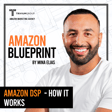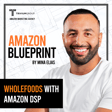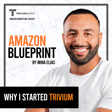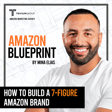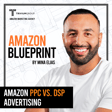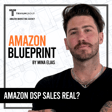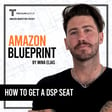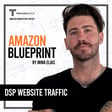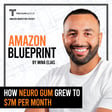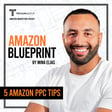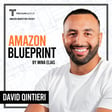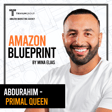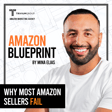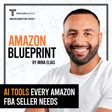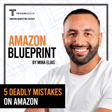Become a Creator today!Start creating today - Share your story with the world!
Start for free
00:00:00
00:00:01

How to Launch a Product on Amazon Like a Pro: Step-by-Step Proven Strategy
If you want your product to succeed on Amazon, your launch strategy has to be perfect.
And that starts with getting the basics right.
I’ve launched products on Amazon that made millions, and I’ve helped hundreds of brands do the same.
In this podcast, I’m breaking down the exact step-by-step strategy to nail your Amazon product launch and avoid the mistakes that kill sales.
I’ve been there, done it, and launched products to #1 on Amazon.
Follow this step-by-step strategy to make sure you’re setting yourself up for success.
🚀 Need help launching? Fill out this form: https://hubs.la/Q037x_qL0
Transcript
The Importance of Product Launch on Amazon
00:00:00
Speaker
Welcome back to the Amazon Blueprint Podcast.
00:00:05
Speaker
The most important thing that is going to determine whether your product is going to fail or succeed on Amazon is your product launch. No matter how good your product is, if you flop your product launch, it is going to fail, it's not going to make money.
00:00:17
Speaker
Now, a lot of people also mess up their product launch by launching really well and then running
Expert Insights on Stock Management
00:00:22
Speaker
out of stock. I'm going to walk you step by step exactly how to nail your product launch. how to have a perfect product launch so your product makes millions of dollars on Amazon. Now I've launched my own product hard work successfully on Amazon and generated millions of dollars.
00:00:34
Speaker
And not only that Trivium, my agency has launched hundreds of products on Amazon very successfully. Now some of them not so successfully because of external things like running out of stock. Now I know exactly what to do and how to launch a product perfectly. going to show you step by step.
00:00:47
Speaker
It's actually a lot simpler than you think. All right, step number one, inventory management. The most important thing is never running out of stock. When you run out of stock on Amazon, it is the equivalent of cutting both of your legs off. This is literally the equivalent of it. So if there's one thing you should not do, it's run out of stock on Amazon, which means inventory management needs to be
Inventory Strategies to Prevent Stockouts
00:01:06
Speaker
perfect. Now, how do you have a perfect inventory management?
00:01:08
Speaker
Number one, you need to estimate how much you're going to sell. Now, here's what I do. I go and I look up my competitors that have 100, 200, 300 reviews. How many units are they selling per day and per month? So let's assume that you know they're selling 500 per month.
00:01:21
Speaker
So 500 per month, how many months of inventory do I need? Now, let's say for my supply chain, it takes two months end to end from the time that I make the order until the time it arrives to Amazon, right? And checks in and all that kind of stuff. Let's call it two months, right?
00:01:34
Speaker
I will order at least six months of inventory, three times that. Why? Number one, it gives me a buffer to sell more, to sell faster. Number two, it also allows me in the case that I have any shipping problems or Amazon is taking a little bit longer to check in, you need a buffer of at least 60 days a day. of additional inventory in case everything goes wrong, you still have 60 days left of inventory and you have all of that buffer.
00:01:56
Speaker
Again, the reason is this is how your sales are gonna be when your inventory. If you run out of stock and try to get it back, it's not gonna go back up. Trust me, so many people come to me and they say, Mina, oh my God, we were doing so amazing and dah, dah, dah. And you know, we ran of inventory and now we can't get it back. Please help us with the PPC. I'm like,
00:02:14
Speaker
there's nothing I can do. There's no amount of amazing PPC, there's nothing, right? If you fuck up your product launch because of your inventory management or mismanagement, it's just never gonna come back. So plan for a lot of inventory. And if you're the type of person that's saying, well, you know, what if I wanna
Tools for Testing and Researching Products
00:02:29
Speaker
test the product? What if I wanna just send like a few hundred units?
00:02:32
Speaker
There is no point, right? You're either all in and you know you can be all in by testing you know on PickFu and making sure like, hey, like people actually like my product versus my competitors. Go do you know consumer groups or whatever and go talk to the people and say, hey, do you like this product? Do you like that product? you know My friend, Sean, he does blind taste tests. He actually goes to gyms.
00:02:50
Speaker
has his product and then Orgain, his competitor, and he makes people taste it and they're like, oh yeah, I love your product more. So these are all things that can make you confident when you're launching your product. If you feel like, oh, I wanna test it with a few hundred units before going on Amazon, it's just not gonna work, okay? All right, next, a perfect listing. Do not launch on Amazon unless your listing is perfect.
00:03:09
Speaker
Why would it not be perfect? You can see your competitor's listings. You can see their images, you can see their videos, you can see everything on their listing. Why would you not have a perfect listing before launching? so Here's what I do. I go and I look at my top three competitors. I go look at their listings and I look at their images. I look at their, you know, all of the stuff that is in their listing, the brand story, premium, plus content.
00:03:29
Speaker
And when I'm creating my content, number one, i want to make sure my main image is better than their main images. And I use something like PigFoo. I also use you know focus groups and consumer groups. And I say, hey guys, which of these images do you like the most?
00:03:41
Speaker
And I actually get feedback from people that tell me my main image is the best one. So that's number one. Number two, the rest of the images, they need to sell the product really easily. So a lot of times I'll go to completely random people, you know who are my friends, and I say, hey, here's images.
00:03:55
Speaker
Tell me exactly what this product is, what it does, and why it's better than everyone else. And if they can't tell me exactly just from the images, my images aren't communicating the benefits of the product well enough. And then I do the same thing with the brand story, premium A plus content.
00:04:07
Speaker
And then another thing that I do is I use Jungle Scout and I use their AI that reads the reviews. And I go through all these products and I see what are all of the negative things that my competitors have? What are all of the positive things that they have?
00:04:19
Speaker
And I try and incorporate as much of that into my listing. I say, hey, we don't have any of the negatives that you complained about in my competitor's products. We have all of the positives that all of the competitors have. So I make sure that all of that stuff is incorporated in my listing. I make sure the copywriting is good. I make sure that the SEO is good.
00:04:33
Speaker
I use
Optimizing Listings and Pricing Strategies
00:04:34
Speaker
Datadive. It's very simple. I have a video right here where I spent an hour with Brandon, step by step, how do you create perfect SEO for your listing? And I look and I say, My competitors have, you know, 150,000 score, 180,000 score.
00:04:46
Speaker
I can literally write my listing and make sure that I have a 200,000 score and beating all of my competitors. So there's no excuse for you not to have a perfect listing before you ever launch. All right, next pricing.
00:04:57
Speaker
I like to always start a lower pricing than most of my competitors. So let's say the range is $20 to $40. I'll start maybe If i'm too low, twenty or ninety ninety nine whatever I might be perceived as too cheap, right? And people might be scared.
00:05:12
Speaker
If I'm at 24, 25, most people understand this is a newer product. So it's coming in at a lower price. If I try and start at 30, 35, or even 40 to be a premium product, the problem is I don't have the reviews to back it up. People might not trust like, okay, why is this guy asking for $40, right? We don't know. We don't trust this product. No one's commenting on it. There's no reviews. So how can I trust that it's actually the product? Next, a review strategy.
00:05:35
Speaker
Do not even launch on Amazon if you don't have a review strategy. Okay, no matter what you do, if you have, if you've created something that cures cancer with no reviews, people are not gonna trust it, right? You guys know this, right? You know if like someone says, hey guys, like has anyone tried this cancer treatment that no one has ever tried, you're not gonna try it on yourself. so that's how important reviews are so have a review strategy vine is a great way to you know get reviews you can use feedback 5 to automate the request review button those are not going to work that much right the best way is to have a strategy again i have a video i'm going to link in the description it is literally like how to optimize your conversion rate on amazon and it talks about my review strategy which is basically i identify a bunch of people that are the ideal people for my product and i give them the product for free in exchange for a review it is against terms of service
00:06:19
Speaker
I try and word it very nicely, like say, hey, I'm looking for feedback on my product. You know, just want honest feedback. And then you give them the product. And if their honest feedback is good, ask them to leave it on Amazon. Next, let's talk about the actual launch on Amazon.
Keyword Research and PPC Campaigns
00:06:31
Speaker
So first of all, we need to do some keyword research because PPC is gonna drive the majority of this. And I'm gonna talk about something else, like a nice little bonus. But PPC is gonna drive the majority of the sales. So we need to do keyword research.
00:06:42
Speaker
I like to use Data Dive. You can also use Jungle Scout or Helium 10. Do a reverse ASIN lookup on your top 10 competitors. pull all of their keywords, I like to find the intersection between those keywords. So at least, you know, eight out of 10 minimum ranking competitors, which means, you know, nine or 10 out of 10 of all of the products rank for the same keywords. I don't want, you know, keywords that people only one or two products are ranking for because it could be just specific to them. So I want the intersection. I also want to make sure that the max position is 60. So if, you know, some products are ranking 130 for a keyword, not really relevant.
00:07:11
Speaker
And then usually 500 searches or more, right? Even maybe a thousand searches or more because if the keyword volume is not that much, it doesn't really matter to me. So anyways, Datadive does this in two seconds. So I'd rather just go for Datadive.
00:07:22
Speaker
I pull the master keyword list and then on Amazon, how I structure my campaigns. Number one, auto campaigns. I break them up. I want close match and I want substitutes. Loose match and compliments are a little bit too loose, you know, loose.
00:07:34
Speaker
So I don't like to use them right away. So close match, substitutes, separate campaigns. I'll talk about campaign structure, like budget and all that stuff in a second. Anyways, next, I take the main keywords, the top five main keywords. I do one keyword per campaign, one broad, one phrase, one exact. So that's five times three 15 campaigns just with the main keyword.
00:07:51
Speaker
I know it sounds crazy. It's a lot, but trust me, just follow me here. Next, I take the other probably 45 keywords. They're usually like mid to long tail. And I'll do five keywords per campaign. Again, five broad, five phrase, five exact. So that's going to be maybe another, you know, 15, let's call it.
00:08:06
Speaker
Then from there, I'm going to one campaign. That's a competitor targeting campaign. And that is for my main competitors. Now I'm not expecting this to be profitable, but it will add the relevancy of the product. so it will say that my product is the same as these other competitors, which will help with the indexation and and the cataloging inside of Amazon. So it has like a hidden benefit, but it's not going to be profitable. Anyways, how should budgeting work? So for all of the campaigns, it's a hundred dollar minimum daily budget.
00:08:31
Speaker
It's not going to be 100 times whatever, 15 and 15 and whatever. It's not going to be that much, right? Because my bids, I'm going to start low. So I always start with lower bids and then I increase the bids so I'm pacing myself. So I'm not like just skyrocketing my spend from day one. Now, what should you expect in terms of spend? So when you first start, your spend and sales are probably going to be the same. so you're going spend 100, make 100.
00:08:50
Speaker
spend 200 make 200 spend 300 make 300 now a lot of people expect like you're gonna launch spend spend spend and then you're gonna cut down the spend and your sales are gonna continue to go up that's not how it works right you don't want to cut down on your spend you want to keep increasing the spend but you want to increase your conversion rate so that your total revenue increases and you actually end up with a bigger gap, which means your total sales are higher, which means you start becoming more profitable.
00:09:15
Speaker
So how do I do this financially? Right? Because all of us have a limit. What I do is I set a limit for myself in terms of loss and profit. So for example, month one, two and three, I'm okay losing $4,000 month, right? Negative $4,000 a month.
00:09:26
Speaker
but negative four thousand dollars a month Now, month four and five, negative 2,000. Month six, negative 1,000. Month seven, I wanna be at zero. Month eight, you know, whatever, I wanna be profitable. So that's my first seven months.
00:09:38
Speaker
What I'm gonna do is I'm gonna start spending money every single day. I'll start with at least, you know, 100 or 200 a day, ideally more like 300 a day. So I'll start there. And I'll look at how much my loss is.
00:09:48
Speaker
And I'll keep spending more and more money on PPC until my loss is negative
Financial Planning for Initial Launch Phases
00:09:53
Speaker
4,000. Now, if you have a shit product, a shit listing, all that stuff, you know, you're going to lose the negative 4000 very easily, right? With only $100 in ad spend.
00:10:01
Speaker
But if your listing is amazing, your product is amazing. All that stuff is good. What's going happen is that you can keep pushing the spend and then eventually you're going hit that negative 4000. But it could be a nice spend. It could be spending 500 day making 750 day sales. And then next month,
00:10:14
Speaker
and then the next month Now you've had time to accumulate at least 30, 45 reviews, hopefully more, maybe 60 reviews, you're close to 100, right? So now your conversion rate's a little bit better. So you can spend a little bit more, 500, 600 a day, and then your sales are gonna be getting better and better because conversion rate is improving because reviews are coming in.
00:10:32
Speaker
So then you can spend more and more and still be at that negative 4,000. four thousand And then, you know, the next month you're like, okay, I need to only hit negative 2000. So you keep spending more, but as soon as you hit that negative 2000, you stop the spend right there. So that's essentially the game is you're trying to get conversion rate as high as possible so you can spend more.
00:10:51
Speaker
Why? Because I want to break even, not at $8,000 a month in revenue, at $80,000 a month in revenue. Because if I can break even at 80,000 in revenue, if I cut down my ad spend by 10K, now I made 10K in profit.
00:11:04
Speaker
But if I'm at 8,000, what am I gonna do? The maximum I can make is maybe a thousand in profit, right? So you see 10K and 1K, huge difference in the amount of profit that you can make. So that's why, you know, your loss is still the same, right? Obviously it's gonna be a little bit more cashflow intensive. So you're gonna need to front more and more and more and more inventory faster. so you know, have a plan for that, have a bunch of money allocated to inventory. And again, inventory capital is not an expense unless you completely are fucking blowing money and going way beyond the negative 4,000. But inventory capital is just a storage of value. So you're taking, you know, $10 of cash, putting in $10 of a product that then gets sold, you get the $10 back.
00:11:43
Speaker
So even if I invest $80,000 into inventory, that's not an expense. That's literally, I'm just transforming the value of my cash into inventory. It's sitting there. Once it sells, I'm going to get my 80,000 back, you know, cost of goods sold.
00:11:55
Speaker
And then either I'm going to lose some money because I'm not profitable or I'm going to make some profit. So again, don't think of inventory as a loss, but that's essentially the launch strategy.
Leveraging TikTok for Amazon Traffic
00:12:04
Speaker
This is a perfect launch strategy. Now, here's the bonus that I promised you guys.
00:12:08
Speaker
How can you throw fuel on the fire? If you this is your launch, how can you make it 10x better? TikTok shop. Here's what I do with TikTok shop. before even launching on Amazon, I am reaching out to the top creators in my category.
00:12:20
Speaker
I'm doing manual outreach. I'm courting them. I'm basically saying, you you know, hey, we have this amazing product. So I'm actually working on a new brand right now. So I'm reaching out to these influencers or these content creators on TikTok shop. And I'm saying,
00:12:31
Speaker
Hey, I want to work with you. I want us to develop a relationship. I want to give you the product for free in exchange for like just some feedback and I'm going to pay you to make some content. So I'm actually paying them ahead of time. So I have 50 people with the product ready with content. And I'm like, okay, the product is going launch on Amazon on this date. So I want all of you on this exact date to post your videos on TikTok shop. Now, what I'm going to do is once they all post their videos, yeah, they might get some, you know, good coverage, whatever. but I'm taking all of their spark codes, which is the unique code attached to their video. And I'm creating one GMV max campaign, putting, you know, a hundred dollars or whatever behind it. And then I'm spending money on ads to scale their videos. So they're getting way more impressions. Now, the beauty of that is when it's all these creators, these influencers that their videos is getting views.
00:13:17
Speaker
It looks way more organic than if me as a brand, I'm pushing my own product. And so all of the people are gonna see the product on TikTok shop. They're not gonna buy on TikTok shop. Most likely they're not. What they're gonna do is they're gonna go check out the product on Amazon.
00:13:30
Speaker
And on the launch, they're gonna go, they're gonna see it. Because of the social proof of the 50 videos and they're seeing all these different people on TikTok shop talking about the product, they're gonna be okay with like the reviews. Obviously, if I had one thousand reviews, it will convert way better.
00:13:42
Speaker
But even if I don't have any reviews, it's fine. People are gonna come in and Amazon absolutely loves that external traffic. When they see traffic coming in from TikTok shop, onto Amazon. Even if 1% of it is converting, Amazon loves this because you just helped their business. You brought all these people from a different platform onto their platform. Instead of just being someone who takes from Amazon, you actually gave to them.
00:14:03
Speaker
And what I've noticed is organic ranking naturally skyrocket. you know We've seen this with a lot of brands. NeuroGum is a great example because every time they launch a product, they have all this external traffic from like Joe Rogan talking about them or their Shark Tank episode airing again and or being on TV or whatever.
00:14:19
Speaker
And so they get all this external traffic and their products naturally rank organically like unusually better than other products. And of course, they have an amazing product, an amazing listing. All right, guys, this was a masterclass on how to launch your product on Amazon.

